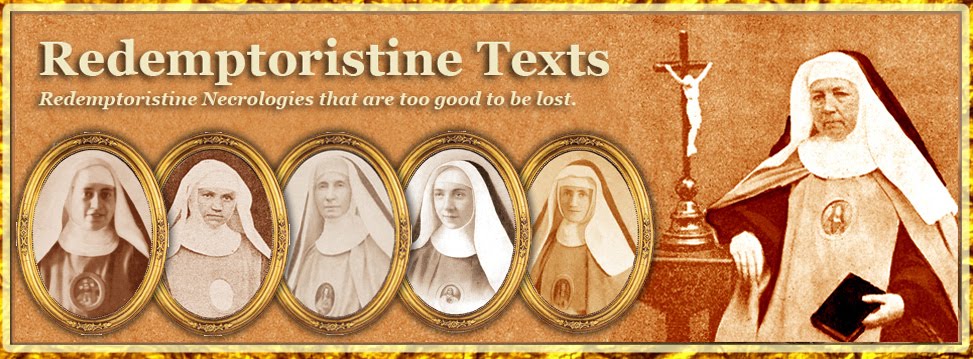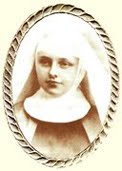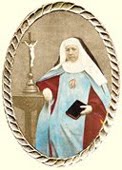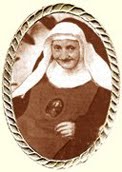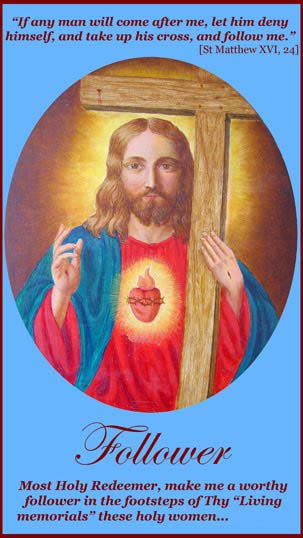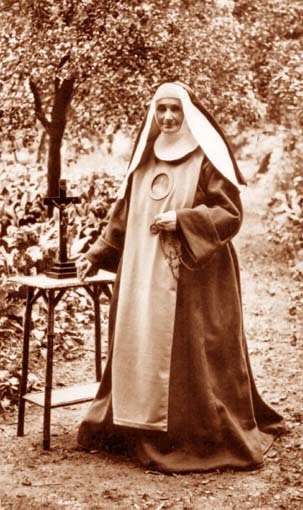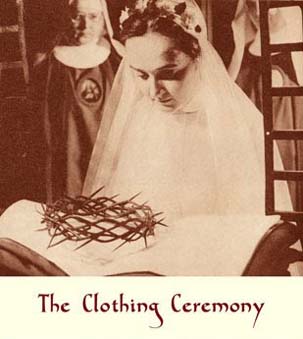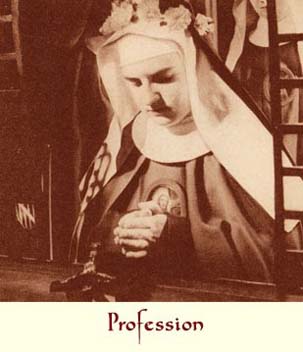Born Jeanne Koch
Sister Marie-Cecile of the Precious Blood was born at Innsbruck (Tyrol) on 24th June 1821, of parents of an ordinary station in life. Brought up piously by her mother, little Jeanne, from the moment of her first communion, felt herself so strongly attracted to the religious life that even then she made a vow of perpetual chastity. Her love of prayer was already extraordinary. At the age of twelve, she entered the Third Order of Saint Francis, and as her confessor recognized the signs of a vocation to the contemplative life in her, she learned to play the organ, so that she might be admitted one day into a monastery, in spite of lacking a sufficient dowry. But at just that very time, the Convent of the Redemptoristines in Vienna was looking for an educande who understood music. So Jeanne succeeded, with the help of her other qualities, in being admitted. She was then seventeen years of age.
Pious indeed though she may have been, she did not cease to severely test the patience of the Mother Mistress through the impetuosity and noisy vivacity of her character. But her good will, aided by the grace of God, triumphed over this defect, and ten months after her entry into the monastery, Jeanne was as though transformed! During her novitiate she was seen to make astonishing progress in virtue. Her love of prayer became a grace of high contemplation, and she received extraordinary favours from heaven. Her devotion to the Holy Child Jesus made her in her turn resemble an innocent child. Her candour and the purity of her soul were reflected in her features and in her eyes. Almost every year, the approach of Christmas saw her become completely ill, so much did she long for this touching feast! Her heart would beat violently, thinking of the coming of the Saviour of mankind, and she even went so far as to start spitting blood, so great was her emotion. But once the feast actually arrived she recovered her former health. She displayed the same ardour for the Blessed Sacrament of the altar. She was often seen remaining motionless for hours on end before the holy Tabernacle, and whenever she took Communion, she was transported so far out of herself that for several hours she was quite unable to take any food.
Sister Marie-Celeste’s virtues were the best guarantee of the heavenly origin of these favours. Her love of regular observance was admirable. Her humility made her give preference to performing the most distasteful tasks, in spite of the opposition of her character, which was by nature somewhat proud. Insatiable for mortification, she persuaded her confessor to intercede with her Superior to give her a little more liberty to appease her thirst for penance. She had been encouraged in it, she said, by Jesus Christ Himself. And yet her obedience was the greatest of her other virtues.
The novices had the custom, on 25th of the month, to write a letter to the Holy Child Jesus in which they expressed their desires. Sister Marie-Cecile continued this custom after her profession, but she would always give her letter to her Superior to read and approve. One day when she had just accomplished this act, she met a Sister who asked her why she had so joyful an air. She replied: “It is because I have just read out to my Superior my letter to the Holy Child Jesus, but next month, I will bring it to you.” And in fact, the following month, this Sister had become the Superior. In addition to this it was noted that Sister Marie-Cecile knew many things that she could not have known naturally, and she often even knew of the thoughts and dispositions of others.
* * * * *
Sister Marie-Cecile had received the holy habit on 20th August 1839. She had to wait until 20th August 1842 to make her profession, since the laws of Austria required this delay. And so the close union that she contracted with the divine Redeemer caused her to make new progress in perfection. For their part, her Superiors thought of making a more direct use of her talents. The Mistress of Novices asked her for spiritual exercises for the times of Advent and Lent. The young professed acquitted herself of this task with success. Charged with care of the educandes, she succeeded marvellously in forming them well. A Sister, greatly troubled in both her body and soul, was confided to her care, and she healed her in both respects. However, these different tasks and the macerations she inflicted on herself, adversely altered her health. She became so feeble that, to play the organ, she had need of a support to sustain her. She often lost sleep, but her infirmities in no way altered the vivacity of her spirit and the joy of her heart. If they pitied her over her insomnia, she would reply: “I was not alone.”
The Revolution of 1848 was the last and supreme trial for the poor Sister. Driven from her convent, she had to take refuge in a private house, and then painfully find her way to Innsbruck, her native town, and ask for shelter from her married sister who, poor herself, could not, in spite of her excellent heart, give her all the help necessary. Sister Marie-Cecile, ill, bed-ridden, consumptive, often subject to spitting up blood, also saw herself separated from her Superior and her Sisters in religion. But this pain, for her the most bitter one, was the triumph of her love for her divine Spouse. Her resignation was heroic, and the Sisters of Mercy in Innsbruck, who gave her shelter in their monastery, admired in her the patience and charity of a saint. She died only slowly, but the joy of soon contemplating Him whom she loved so much shone out on her face. When she had received the last sacraments, Father Ladinski, a Redemptorist, had her renew her vows of religion by pronouncing the consecrating formula with her. But he deliberately put the vow of obedience in the last place. When he arrived at the word Obedience, he stopped and said to the dying woman: “Sister Marie-Cecile, you have always loved obedience, so practise it now in this supreme moment: die now through obedience and the love of Our Lord.” At the same instant, she inclined her head and rendered her soul to God. This was on 30th March 1849, on the feast of the Compassion of the Blessed Virgin.
The virginal body of Sister Marie-Cecile, clad in her Redemptoristine habit, was then laid out in the monastery parlour. An incredible number of the faithful from all classes of society hurried to these precious remains and venerated the humble bride of Jesus crucified. Her funeral was more solemn than that of a princess. The divine Saviour glorified in this world she who had vowed all her love to Him.
Pious indeed though she may have been, she did not cease to severely test the patience of the Mother Mistress through the impetuosity and noisy vivacity of her character. But her good will, aided by the grace of God, triumphed over this defect, and ten months after her entry into the monastery, Jeanne was as though transformed! During her novitiate she was seen to make astonishing progress in virtue. Her love of prayer became a grace of high contemplation, and she received extraordinary favours from heaven. Her devotion to the Holy Child Jesus made her in her turn resemble an innocent child. Her candour and the purity of her soul were reflected in her features and in her eyes. Almost every year, the approach of Christmas saw her become completely ill, so much did she long for this touching feast! Her heart would beat violently, thinking of the coming of the Saviour of mankind, and she even went so far as to start spitting blood, so great was her emotion. But once the feast actually arrived she recovered her former health. She displayed the same ardour for the Blessed Sacrament of the altar. She was often seen remaining motionless for hours on end before the holy Tabernacle, and whenever she took Communion, she was transported so far out of herself that for several hours she was quite unable to take any food.
Sister Marie-Celeste’s virtues were the best guarantee of the heavenly origin of these favours. Her love of regular observance was admirable. Her humility made her give preference to performing the most distasteful tasks, in spite of the opposition of her character, which was by nature somewhat proud. Insatiable for mortification, she persuaded her confessor to intercede with her Superior to give her a little more liberty to appease her thirst for penance. She had been encouraged in it, she said, by Jesus Christ Himself. And yet her obedience was the greatest of her other virtues.
The novices had the custom, on 25th of the month, to write a letter to the Holy Child Jesus in which they expressed their desires. Sister Marie-Cecile continued this custom after her profession, but she would always give her letter to her Superior to read and approve. One day when she had just accomplished this act, she met a Sister who asked her why she had so joyful an air. She replied: “It is because I have just read out to my Superior my letter to the Holy Child Jesus, but next month, I will bring it to you.” And in fact, the following month, this Sister had become the Superior. In addition to this it was noted that Sister Marie-Cecile knew many things that she could not have known naturally, and she often even knew of the thoughts and dispositions of others.
* * * * *
Sister Marie-Cecile had received the holy habit on 20th August 1839. She had to wait until 20th August 1842 to make her profession, since the laws of Austria required this delay. And so the close union that she contracted with the divine Redeemer caused her to make new progress in perfection. For their part, her Superiors thought of making a more direct use of her talents. The Mistress of Novices asked her for spiritual exercises for the times of Advent and Lent. The young professed acquitted herself of this task with success. Charged with care of the educandes, she succeeded marvellously in forming them well. A Sister, greatly troubled in both her body and soul, was confided to her care, and she healed her in both respects. However, these different tasks and the macerations she inflicted on herself, adversely altered her health. She became so feeble that, to play the organ, she had need of a support to sustain her. She often lost sleep, but her infirmities in no way altered the vivacity of her spirit and the joy of her heart. If they pitied her over her insomnia, she would reply: “I was not alone.”
The Revolution of 1848 was the last and supreme trial for the poor Sister. Driven from her convent, she had to take refuge in a private house, and then painfully find her way to Innsbruck, her native town, and ask for shelter from her married sister who, poor herself, could not, in spite of her excellent heart, give her all the help necessary. Sister Marie-Cecile, ill, bed-ridden, consumptive, often subject to spitting up blood, also saw herself separated from her Superior and her Sisters in religion. But this pain, for her the most bitter one, was the triumph of her love for her divine Spouse. Her resignation was heroic, and the Sisters of Mercy in Innsbruck, who gave her shelter in their monastery, admired in her the patience and charity of a saint. She died only slowly, but the joy of soon contemplating Him whom she loved so much shone out on her face. When she had received the last sacraments, Father Ladinski, a Redemptorist, had her renew her vows of religion by pronouncing the consecrating formula with her. But he deliberately put the vow of obedience in the last place. When he arrived at the word Obedience, he stopped and said to the dying woman: “Sister Marie-Cecile, you have always loved obedience, so practise it now in this supreme moment: die now through obedience and the love of Our Lord.” At the same instant, she inclined her head and rendered her soul to God. This was on 30th March 1849, on the feast of the Compassion of the Blessed Virgin.
The virginal body of Sister Marie-Cecile, clad in her Redemptoristine habit, was then laid out in the monastery parlour. An incredible number of the faithful from all classes of society hurried to these precious remains and venerated the humble bride of Jesus crucified. Her funeral was more solemn than that of a princess. The divine Saviour glorified in this world she who had vowed all her love to Him.
This necrology is translated from Fleurs de l'Institut des Rédemptoristines by Mr John R. Bradbury. The copyright of this translation is the property of the Redemptoristine Nuns of Maitland, Australia. The integral version of the translated book will be posted here as the necrologies appear.
